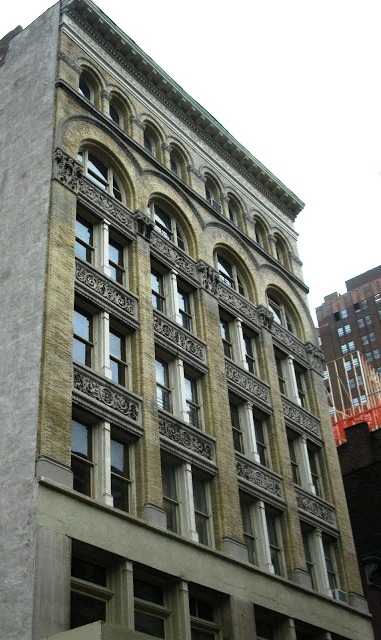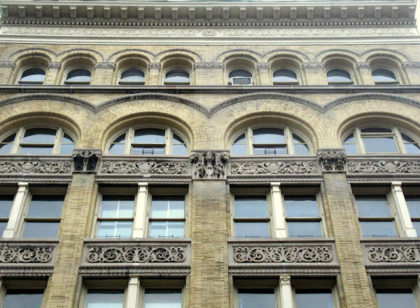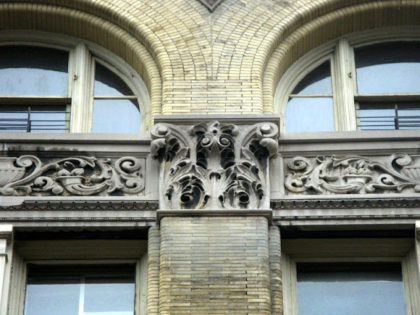The History of 60-62 Lispenard
 Tom Miller, who writes about the history of Manhattan buildings at Daytonian in Manhattan, has allowed Tribeca Citizen to create a database of his Tribeca posts. If you enjoy these, and you will, then you should definitely check out his website, which also has write-ups about buildings all over the island. And don’t miss his book, Seeking New York: The Stories Behind the Historic Architecture of Manhattan—One Building at a Time.
Tom Miller, who writes about the history of Manhattan buildings at Daytonian in Manhattan, has allowed Tribeca Citizen to create a database of his Tribeca posts. If you enjoy these, and you will, then you should definitely check out his website, which also has write-ups about buildings all over the island. And don’t miss his book, Seeking New York: The Stories Behind the Historic Architecture of Manhattan—One Building at a Time.
··································
 In the early 18th century when city alderman Anthony Rutgers purchased the large section of land north of the city, much of which we now know as Tribeca, the area was mostly unusable marshland. Shortly after receiving a grant on the land in 1730, he began draining the swampy meadow.
In the early 18th century when city alderman Anthony Rutgers purchased the large section of land north of the city, much of which we now know as Tribeca, the area was mostly unusable marshland. Shortly after receiving a grant on the land in 1730, he began draining the swampy meadow.
Leonard Lispenard purchased the land in 1746, incorporating it into the Lispenard Farm. It then became part of Lispenard’s tremendous holdings that stretched to the Hudson River, called Lispenard Meadows. As the city inched northward and streets were laid out, the Lispenard name became attached to some of them: Leonard’s children, Leonard and Anthony both gave their names to streets; and the small road running parallel to Canal Street to the south was given the name Lispenard Street.
In the first quarter of the century Lispenard Street was lined with modest brick homes, most of which would last only a few decades. By the time of the Civil War commercial buildings were replacing them as Canal Street and Broadway became important business thoroughfares. As the century drew to a close, two small houses—each two stories tall—still held on at Nos. 60 and 62 Lispenard Street. They had been converted to serve as John H. Ireland’s Star Hotel—a somewhat seedy establishment with often-questionable goings on.
On June 12, 1894, the New York Building & Improvement Company purchased the buildings and began plans for an impressive new office and loft building. Gilbert A. Schellenger received the commission, although his was commonly thought of as a residential architect. In No. 60-62 Lispenard he would prove that he was up to the task of major commercial buildings as well.
The architect produced a seven-story Italian Renaissance beauty. Rusticated stone piers at street level were separated by decorative and utilitarian cast iron store fronts. Above the stone second story, the building rises in buff-colored brick with elaborate carved stone panels delineating the fourth through sixth floors. The arched openings of the top two floors—four at the sixth balanced by eight at the seventh—complete the design that would be more expected on an avenue than a tiny side street.
Construction was completed in 1895 and a variety of tenants filed in. Among them was the John W. Doubleday manufacturing firm. Working with him were his sons Charles Albert and John M.
The often repeated Tribeca legend is that former mayor and entrepreneur William Russell Grace ran his business from the building; but Grace had purchased the former Cotton Exchange building at 1 Hanover Square in 1885 and remained there until his death in 1904.
 Classical motifs such as urns and cornucopias decorate the panels.
Classical motifs such as urns and cornucopias decorate the panels.
··································
Firms that certainly were here, however included the factory of C. H. S. Jaffray (who was fined in 1904 by building inspectors for neglecting to light the halls and stairways leading to the workrooms), and P. W. Lambert &, Co., that manufactured “fancy leather goods.” By 1906 the firm was so successful that it moved to the building next door, eventually taking over the entire building and leasing additional factory space again in No. 60-62.
With the millinery and apparel districts nearby on Broadway, the building naturally attracted manufacturers in these or related trades. In 1910 Schulman & Shapiro was doing business here when the company was charged with employing children under 14 years of age. The same year America’s Textile Reporter noted the consolidation of two large “balers, folders, and packers of dry goods.” Upon the death of Col. William H. Hubbel, whose loft was in the building, the Duane Street firm of Hinman & Taylor purchased the business. “They now have a plant second to none as far as equipment is concerned,” said the Reporter, “and are in a position to double and roll goods by machinery in a manner equal to the best work turned out by the mills, and at low prices.”
The Dominican Leather & Shoe Manufacturing Company was here along with Joseph Weinstein & Co. in the first decades of the century. As the age of the automobile arrived, several of the textile and apparel companies turned their attention to the new opportunities—like automobile covers and lap robes. Among them was the B. E. Mfg. Company which was here in 1913.
Although the building continued to attract mainly apparel and textile firms, there were others as well, like the Boxner Medicine Company. In 1918 Boxner’s “medicinal preparations” were made for both domestic and foreign trade.
Another tenant, Fisher Stevens Service, liked the building so much that they bought it. On September 24, 1920, The New York Tribune reported on the sale by owner Hyman Benowitz. Two years later Leiman Brothers would be renting in the building, making “pumps for automatic feeders, folders and labelers.”
 The dignified building hiding on little Lispenard Street continued to be home to apparel manufacturers throughout the decades. Federal Sportswear, for instance, was here during the Depression years.
The dignified building hiding on little Lispenard Street continued to be home to apparel manufacturers throughout the decades. Federal Sportswear, for instance, was here during the Depression years.
But with the rediscovery of Tribeca at the turn of the new century, things changed in the Canal Street neighborhood. In July, 2005, No. 60-62 Lispenard Street was converted to nine upscale condominium residences. Inexplicably called “The Wanamaker” (perhaps as a nod to the great department store that stood several blocks north on Broadway), its apartments retain the exposed 19th-century cast-iron columns and high ceilings. The huge spaces—running from 2,500 square feet to 3,700 square feet—were brought into the 21st century with fireplaces, central heating and air conditioning and recessed lighting.
But the exterior of Gilbert Schellenger’s handsome and hidden Renaissance-inspired building remains nearly unchanged after nearly a century and a quarter of use.
··································
Photo credits: Alice Lum (3).










